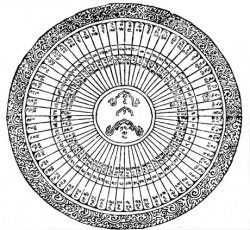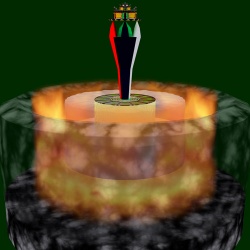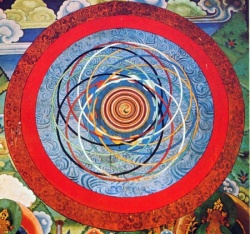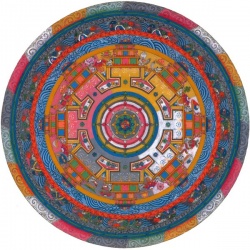Example Kālacakra karaṇa calculations
For those studying the methods of calendrical calculation given in the Kālacakra Tantra and its commentary, the Vimalaprabhā, it is helpful to have a set of example calculations against which to test one's understanding (a translation of the calculations in the Tantra and the Vimalaprabhā is given in chapter five of Kālacakra and the Tibetan Calendar). This will also help illustrate the calculations used in the Kālacakra karaṇa calendar software given here.
This example calculates for the 6th lunar day in the month of Śrāvaṇa (gro bzhin) in the year Virodhin ('gal ba), four years after the Kālacakra Tantra epoch. This equates to Thursday 11 July 810 CE, in the Julian calendar. In order to see these results in the KCK software, set the 806 CE epoch of the Kālacakra Tantra, and then press F3 for the calendar cycle. Enter as date "6 6 810".
In the following, both epoch data and results that are displayed by the software are highlighted in bold. References such as "v.27" refer to the relevant verse in the first chapter of the tantra. Some of the calculations are given in simplified form in the Vimalaprabhā, and where this is the case the full form will also be described and its results used in later parts of the calculation.
v.27: The count of years and the true number of months (zla ba'i tshogs rnam par dag pa)
The count of years is clearly 4, and the month of Śrāvaṇa is 4 months after Caitra. The initial count of months is therefore:
4 × 12 + 4 = 52.
This then has to be corrected, using the formula:
m × 1;4 + 0;0 (130)
52 + 1 = 53 52 × 4 = 208 ÷ 130 = 1 rem. 78
52 × 1;4 = 53;78
This gives the true month as 53.
v.28. Monthly mean weekday (gza'i dhrū ba)
This calculates the mean weekday for the new moon at the beginning of the month. The true month is written in three places, the middle is multiplied by 32, the lower is divided by 6 and subtracted from the middle. Epoch values of 2 and 30 are added to the top and middle places:
53 + 2 + 28 = 83 ÷ 7 = 11 rem. 6 53 × 32 = 1696 – 8 + 30 = 1718 ÷ 28, rem. 38 53 ÷ 6 = 8 rem. 5
As the bottom line quotient is subtracted from the middle, the bottom line can be considered negative. If we convert to normal units of pala (60 per nāḍī), the above result could be written as 6;38,–50. If we then take one nāḍī from the middle place, and add 60 to the pala position, we get:
6;37,10
The normal way of performing this calculation would be:
53 × 1;31,50 + 2;30,0 = 6;37,10
v.29. The lunar anomaly (ril po dang cha shas)
The formula for calculating the anomaly is:
M × 2;1 + 5;112 (28,126)
53 × 2;1 + 5;112 = 0;39
v.29/30. Monthly mean solar longitude
This calculates the mean solar longitude for the new moon at the beginning of the month. The method as given is incomplete. The true month is written in three places. The middle is multiplied by 11, The lower value is multiplied by 39, the result added to 2, and then the total subtracted from the middle position. The top position is multiplied by 2 and the middle divided by 60, carrying to the top position:
53 × 2 = 106 + 9 = 115 ÷ 27 = 4 rem. 7 53 × 11 = 583 – (2 + 1) = 580 ÷ 60 = 9 rem. 40 53 ÷ 39 = 1 rem. 14
As before, the bottom line should be considered negative, so, carrying one from the middle line, we get (39 – 14 = 25) as the result:
7;39,25
Although it is not mentioned in the tantra, the bottom line represents 39th parts of a nāḍī, and can be converted to pala. We do this by multiplying by 60 (the number of pala in a nāḍī) and dividing by 39, and then carrying down to other fractional parts:
25 × 60 = 1500 ÷ 39 = 38 rem. 18 18 × 6 = 108 ÷ 39 = 2 rem. 30 30 × 13 = 390 ÷ 39 = 10
This gives the final result of:
7;39,38,2,10 (13)
The usual calculation would be:
53 × 2;10,58,2,10 + 26;58,0,0,0 = 7;39,38,2,10 (13)
v.30. Approximate calculations for later months
For these approximations, for each further month, 1;32 is added to the mean weekday, 2;1 to the anomaly and 2;11 to the mean solar longitude.
v.31-33. Calculation of the true weekday
First is given an approximation to derive the mean weekday and the anomaly at the required lunar day (6). It is assumed that the mean weekday is written in two places above the anomaly, and for each lunar day, one is added to the weekday place, one subtracted from the nāḍī place, and one added to the anomaly:
6 + 6 = 12 ÷ 7 = 5 37 – 6 = 31 0 + 6 = 6
The anomaly calculation is not an approximation, but the weekday is. The more accurate way would be to add for each lunar day, 0;59,3,4,0:
6;37,10,0 + 6 × 0;59,3,4,0 = 5;31,32,0
| Index | Coefficient | Total |
| 1 | 5 | 5 |
| 2 | 5 | 10 |
| 3 | 5 | 15 |
| 4 | 4 | 19 |
| 5 | 3 | 22 |
| 6 | 2 | 24 |
| 7 | 1 | 25 |
| 8 | 1 | 24 |
| 9 | 2 | 22 |
| 10 | 3 | 19 |
| 11 | 4 | 15 |
| 12 | 5 | 10 |
| 13 | 5 | 5 |
| 0 | 5 | 0 |
Next, as the first step in the calculation for the true weekday, the anomaly is divided by 14. In this example, as the anomaly is 6, the remainder is simply 6 and the quotient zero; as this is an even number this indicates that the correction that is now going to be calculated will be added to the mean weekday.
The remainder from dividing the anomaly by 14 is the step index, and this gives the position in the lunar step table; the fractional part of the anomaly (39) is the interpolation variable. For the index of 6, the total value is 24 and the interpolation coefficient simply 1. The multiplication is trivial in this instance, so, dividing:
- 39 ÷ 126 = 0 rem. 39
- 39 × 60 = 2340 ÷ 126 = 18 rem. 72
- 72 × 6 = 432 ÷ 126 = 3 (to the nearest integer)
This result is now added to the total, taken as a number of nāḍī:
0;24,0,0 + 0;0,18,3 = 0;24,18,3
As the initial division by 14 produced an even quotient, this is now added to the mean weekday to produce the semi-true weekday (gza' phyed dag):
5;31,32,0 + 0;24,18,3 = 5;55,50,3
The correction that is next calculated for the solar longitude will later also be applied to this figure, the semi-true weekday, to produce the true weekday.
v.33-35. Correction for the true solar longitude
First, there is an approximate calculation for the mean solar longitude on the required lunar day. The lunar day is written in two places and the upper is multiplied by 4. The lower is divided by 3, and any quotient is added to the top (nāḍī) place. It also makes sense to multiply any remainder on the bottom place by 20 to convert it to pala. The final result is then added to the (monthly) solar longitude:
- 6 × 4 = 24 + 2 = 26
- 6 ÷ 3 = 2 rem. 0
7;39,38,2,10 + 0;26,0,0,0 = 8;5,38,2,10
A more accurate version of the calculation would multiply the lunar day number by 1/30th of the mean motion of the Sun in one month:
7;39,38,2,10 + 6 × 0;4,21,5,9 = 8;5,50,0,12 (13)
The next step is to subtract the Sun's birth-sign (skyes khyim) from this mean longitude:
8;5,50,0,12 – 6;45 = 1;20,50,0,12
It is not necessary to subtract a half-circle, and so the correction that will be derived will be subtracted from both the mean solar longitude and the semi-true weekday.
The mansion and nāḍī values are now converted into zodiac signs and nāḍī:
1 × 60 + 20 = 80 ÷ 135 = 0 rem. 80
| Index | Coefficient | Total |
| 1 | 6 | 6 |
| 2 | 4 | 10 |
| 3 | 1 | 11 |
| 4 | 1 | 10 |
| 5 | 4 | 6 |
| 0 | 6 | 0 |
The zero is the index into the table and the remainder of 80 is the interpolation variable. In the table, the total is zero and the interpolation coefficient is 6. This is taken as a number of nāḍī, multiplied by the variable, and then divided by 135. Although this is not stated in the tantra, it would also be normal to use the fractional parts below the nāḍī position:
80 × 6 = 480 ÷ 135 = 3 rem. 75
( 50 × 6 + ( 75 × 60 ) = 4800 ÷ 135 = 35 rem. 75
( 0 × 6 ) + ( 75 × 6 ) = 450 ÷ 135 = 3 rem. 45
( 12 × 6 ) + ( 45 × 13 ) = 657 ÷ 135 = 4 (rounded down)
As the total in the table is zero, this result is the full correction, and can be subtracted from the mean solar longitude:
8;5,50,0,12 – 0;3,35,3,4 = 8;2,14,3,8
This is the final true solar longitude (nyi dag). The correction also needs to be subtracted from the semi-true weekday:
5;55,50,3 – 0;3,35,3,4 = 5;52,14,5,9
A small difference here with the software results are due to truncation effects in integer divisions.
v.35. The longitude of the Moon
For the longitude of the Moon at the end of the lunar day, to the solar longitude is added the lunar day value as a number of mansions, and then 6 times the lunar day value (6 × 6 in this example) is subtracted as a number of nāḍī:
8;2,14,3,7 + 6;0,0,0,0 – 0;36,0,0,0 = 13;26,14,3,7
For the Moon's longitude at daybreak, the fractional part of the true weekday is subtracted from the longitude at the end of the lunar day:
13;26,14,3,7 – 0;52,14,5,8 = 12;33,59,3,12
v.35. The yoga, and, v.36., the karaṇa
The yoga is simply the sum of the longitudes of the Sun and Moon (at daybreak):
8;2,14,3,7 + 12;33,59,3,12 = 20;36,14,1,6
The yoga is therefore no. 20: Siddha (grub pa)
For the karaṇa, the lunar day value is multiplied by 2, 1 is subtracted and then the result is divided by 7:
6 × 2 = 12 – 1 = 11 ÷ 7 = 1 rem. 4
This is a rather incomplete calculation, probably because anybody actually doing these calculations would simply look the answer up in a table. The first half of lunar day 6 has karaṇa no. 3, Kaulava (rigs can) and the second half has no. 4, Taitila (til rdung). In this example, as the time of lunar day is 52,14,5,8, this is well past halfway through the day, it was therefore the first half of the lunar day that was in effect at daybreak. The karaṇa was Kaulava.
v.39. Longitude of Rāhu (sgra gcan)
122 is added to the true month, the result is multiplied by 2, and then 1 is added for the full Moon and 2 is added for new Moon (at the end of the month in question). The results are then divided by 460, with repeated multiplications of 27, 60, etc. The final radix is usually taken as 23, although the tantra description stops at the breath position:
53 + 122 = 175 × 2 + 1 = 351
53 + 122 = 175 × 2 + 2 = 352
351 × 27 = 9477 ÷ 460 = 20 rem. 277
277 × 60 = 16620 ÷ 460 = 36 rem. 60
60 × 60 = 3600 ÷ 460 = 7 rem. 380
380 × 6 = 2280 ÷ 460 = 4 rem. 440
440 × 23 = 10120 ÷ 460 = 22 rem. 0
352 × 27 = 9504 ÷ 460 = 20 rem. 304
304 × 60 = 18240 ÷ 460 = 39 rem. 300
300 × 60 = 18000 ÷ 460 = 39 rem. 60
60 × 6 = 360 ÷ 460 = 0 rem. 360
360 × 23 = 8280 ÷ 460 = 18 rem. 0
These results need to be subtracted from a full circle in order to determine the longitude of Rāhu, and then half a circle added for the longitude of the Tail (mjug ma):
Full Moon:
27;0,0,0,0 – 20;36,7,4,22 = 6;23,52,1,1 (23)
13;30,0,0,0 + 6;23,52,1,1 = 19;53,52,1,1 (23)
New Moon:
27;0,0,0,0 – 20;39,39,0,18 = 6;20,20,5,5 (23)
13;30,0,0,0 + 6;20,20,5,5 = 19;50,20,5,5 (23)
v.40. General day (spyi zhag) calculation for planetary longitudes
The true month is multiplied by 30 and the lunar day added. The resulting count of lunar days is written in three places, the lower divided by 707, the middle by 64, the result from the lower two being subtracted from the top:
53 × 30 + 6 = 1596
1596 – 24 = 1572
1596 + 2 = 1598 ÷ 64 = 24 rem. 62
1596 ÷ 707 = 2 rem. 182
It is usual to check this result by adding the epoch weekday, dividing by 7, and then comparing with the current weekday value:
1572 + 2 = 1574 ÷ 7 = 224 rem. 6
As the current weekday value is 5, not 6, we have to reduce the count by 1: 1571
v.40. Mean slow motion longitude of Mars (bkra shis)
167 is added to the general day value, and the result divided by the period of Mars, 687. The resulting remainder (the particular, or specific, day, sgos zhag) is then successively multiplied by 27, 60, etc., and divided by 687. The final radix is taken as 229
The value 167 is the epoch data for the planet, defining its mean longitude.
1571 + 167 = 1738 ÷ 687 = 2 rem. 364
364 × 27 = 9828 ÷ 687 = 14 rem. 210
210 × 60 = 12600 ÷ 687 = 18 rem. 234
234 × 60 = 14040 ÷ 687 = 20 rem. 300
300 × 6 = 1800 = ÷ 687 = 2 rem. 426
426 × 229 = 97554 ÷ 687 = 142 rem. 0
-> 14;18,20,2,142 (229)
v.41/42. True slow motion of Mars (dal ba dag pa)
First, subtract the birth-sign (skyes khyim) of Mars, and then subtract a half-circle ('khor lo phyed) if necessary:
14;18,20,2,142 – 9;30,0,0,0 = 4;48,20,2,142
No half-circle subtraction needed. Therefore the correction that will now be derived will be subtracted. First, convert to signs and nāḍī:
| Index | Coefficient | Total |
| 1 | 25 | 25 |
| 2 | 18 | 43 |
| 3 | 7 | 50 |
| 4 | 7 | 43 |
| 5 | 18 | 25 |
| 0 | 25 | 0 |
4 × 60 + 48 = 288 ÷ 135 = 2 rem. 18
The index into the table is 2, and the interpolation variable is 18. In the table, the total value is 43 and the interpolation coefficient is 7:
18 × 7 = 126 ÷ 135 = 0 rem 126
( 20 × 7 ) + ( 126 × 60 ) = 7700 ÷ 135 = 57 rem. 5
( 2 × 7 ) + ( 5 × 6 ) = 44 ÷ 135 = 0 rem. 44
( 142 × 7 + ( 44 × 229 ) = 11070 ÷ 135 = 82 rem. 0
This interpolation result is added to the total:
0;43,0,0,0 + 0;0,57,0,82 = 0;43,57,0,82
As no half-circle was subtracted, this correction is now subtracted from the mean slow motion to give the true slow motion:
14;18,20,2,142 – 0;43,57,0,82 = 13;34,23,2,60 (229)
v.43/44. Fast motion of Mars (myur ba dag pa)
| Index | Total | Coefficient | Total | Index |
| 1 | 24 | 24 | 0 | 0 |
| 2 | 47 | 23 | 24 | 13 |
| 3 | 70 | 23 | 47 | 12 |
| 4 | 93 | 23 | 70 | 11 |
| 5 | 114 | 21 | 93 | 10 |
| 6 | 135 | 21 | 114 | 9 |
| 7 | 153 | 18 | 135 | 8 |
| 8 | 168 | 15 | 153 | 7 |
| 9 | 179 | 11 | 168 | 6 |
| 10 | 182 | 3 | 179 | 5 |
| 11 | 171 | 11 | 182 | 4 |
| 12 | 133 | 38 | 171 | 3 |
| 13 | 53 | 80 | 133 | 2 |
| 0 | 0 | 53 | 53 | 1 |
First, the true slow motion longitude of Mars is subtracted from the mean longitude of the Sun, adding a full-circle if necessary. First, the lowest fractional units need to be converted:
8;5,50,0,12 (13) -> 12 × 229 = 2748 ÷ 13 = 211 -> 8;5,50,0,211 (229)
27;0,0,0,0 + 8;5,50,0,211 – 13;34,23,2,60 = 21;31,26,4,151
A half-circle needs to be subtracted, so the following correction will be subtracted.
21;31,26,4,151 – 13;30,0,0,0 = 8;1,26,4,151
As a half-circle has been subtracted, the nāḍī value needs to be increased by 30. Now, 8 is the index into the table (right-hand side), and 31 is the interpolation variable. The table gives a total value of 135 and an interpolation coefficient of 21 (reducing).
31 × 21 = 651 ÷ 60 = 10 rem. 51
( 26 × 21 ) + ( 51 × 60 ) = 3606 ÷ 60 = 60 rem. 6
( 4 × 21 ) + ( 6 × 6 ) = 120 ÷ 60 = 2 rem. 0
( 151 × 21 ) + ( 0 × 229 ) = 3171 ÷ 60 = 53 (to nearest integer)
This result is now subtracted from the total figure, as a number of nāḍī:
0;135,0,0,0 – 0;11,0,2,53 = 0;123,59,3,176 = 2;3,59,3,176
Finally, this correction is subtracted from the true slow motion of Mars:
13;34,23,2,60 – 2;3,59,3,176 = 11;30,23,4,113
v.45/46. The longitude of Mercury
The general day count is multiplied by 100, and then 7,123 is subtracted. The result is then divided by 8,797:
1571 × 100 – 7123 = 149977 ÷ 8797 = 17 rem. 428
The resulting remainder is then successively multiplied by 27, 60, etc., with repeated division by 8,797:
428 × 27 = 11556 ÷ 8797 = 1 rem. 2759
2759 × 60 = 165540 ÷ 8797 = 18 rem. 7194
7194 × 60 = 431640 ÷ 8797 = 49 rem. 587
587 × 6 = 3522 ÷ 8797 = 0 rem. 3522
The result is: 1;18,49,0,3522 (8797)
For the slow motion of Mercury, first the birth sign of Mercury is subtracted from the mean solar longitude, adding a whole circle or subtracting a half-circle as necessary:
27;0,0,0,0 + 8;5,50,0,12 – 16;30,0,0,0 = 18;35,50,0,12
| Index | Coefficient | Total |
| 1 | 10 | 10 |
| 2 | 7 | 17 |
| 3 | 3 | 20 |
| 4 | 3 | 17 |
| 5 | 7 | 10 |
| 0 | 10 | 0 |
18;35,50,0,12 – 13;30,0,0,0 = 5;5,50,0,12
A half-circle has been subtracted and so the correction that will now be derived will be added.
Next, convert to signs and nāḍī:
5 × 60 + 5 = 305 ÷ 135 = 2 rem. 35
The index into the table is 2, and the interpolation variable is 35. In the table, the total value is 17 and the interpolation coefficient is 3 (increasing):
35 × 3 = 105 ÷ 135 = 0 rem. 105
( 50 × 3 ) + ( 105 × 60 ) = 6450 ÷ 135 = 47 rem. 105
( 0 × 3 ) + ( 105 × 6 ) = 630 ÷ 135 = 4 rem. 90
( 12 × 3 ) + ( 90 × 13 ) = 1206 ÷ 135 = 8 (rounded down)
This now needs to be added to the total figure, taken as a number of nāḍī:
0;17,0,0,0 + 0;0,47,4,8 = 0;17,47,4,8
Finally, as a half-circle was subtracted, this correction is added to the mean solar longitude:
8;5,50,0,12 + 0;17,47,4,8 = 8;23,37,5,7
| Index | Total | Coefficient | Total | Index |
| 1 | 16 | 16 | 0 | 0 |
| 2 | 32 | 16 | 16 | 13 |
| 3 | 47 | 15 | 32 | 12 |
| 4 | 61 | 14 | 47 | 11 |
| 5 | 74 | 13 | 61 | 10 |
| 6 | 85 | 11 | 74 | 9 |
| 7 | 92 | 7 | 85 | 8 |
| 8 | 97 | 5 | 92 | 7 |
| 9 | 97 | 0 | 97 | 6 |
| 10 | 93 | 4 | 97 | 5 |
| 11 | 82 | 11 | 93 | 4 |
| 12 | 62 | 20 | 82 | 3 |
| 13 | 34 | 28 | 62 | 2 |
| 0 | 0 | 34 | 34 | 1 |
For the fast motion of Mercury, the mean longitude is subtracted from the slow motion.
First the last unit of adjusted solar longitude (mean longitude of the planet) needs to be made compatible with the slow motion longitude:
8;23,37,5,8 -> 7 × 8797 = 61579 ÷ 13 = 4736 -> 8;23,37,5,4736
Next, subtract the mean longitude from the slow motion. In this instance a full circle needs first to be added:
27;0,0,0,0 + 1;18,49,0,3522 – 8;23,37,5,4736 = 19;55,11,0,7583
A half-circle needs to be subtracted, and therefore the correction that will be derived will later be subtracted:
19;55,11,0,7583 – 13;30,0,0,0 = 6;25,11,0,7583
As a half-circle has been subtracted, the nāḍī value needs to be increased by 30. Therefore, 6 is the index into the table (right-hand side), and 55 is the interpolation variable. The table gives a total value of 97 and an interpolation coefficient of 5 (reducing).
55 × 5 = 275 ÷ 60 = 4 rem. 35
( 11 × 5 ) + ( 35 × 60 ) = 2155 ÷ 60 = 35 rem. 55
( 0 × 5 ) + ( 55 × 6 ) = 330 ÷ 60 = 5 rem. 30
( 7583 × 5 ) + ( 30 × 8797 ) = 301825 ÷ 60 = 5030 (to nearest integer)
This now needs to be subtracted from the total figure, as a number of nāḍī:
0;97,0,0,0 – 0;4,35,5,5030 = 0;92,24,0,3767 = 1;32,24,0,3767
Finally, this correction is subtracted from the mean longitude of Mercury:
8;23,37,5,4736 – 1;32,24,0,3767 = 6;51,13,5,969 (8797)
v.46/47. The longitude of Jupiter
2,600 is subtracted from the general day count, and then the result is divided by 4,332. In our case, we first have to add 4,332, as the general day figure is smaller than the epoch value to be subtracted:
4332 + 1571 – 2600 = 3303
This result is then successively multiplied by 27, 60, etc., with repeated division by 4,332. The final radix is 361:
3303 × 27 = 89181 ÷ 4332 = 20 rem. 2541
2541 × 60 = 152460 ÷ 4332 = 35 rem. 840
840 × 60 = 50400 ÷ 4332 = 11 rem. 2748
2748 × 6 = 16488 ÷ 4332 = 3 rem. 3492
3492 × 361 = 1260612 ÷ 4332 = 291
The mean slow motion longitude of Jupiter is: 20;35,11,3,291 (361)
| Index | Coefficient | Total |
| 1 | 11 | 11 |
| 2 | 9 | 20 |
| 3 | 3 | 23 |
| 4 | 3 | 20 |
| 5 | 9 | 11 |
| 0 | 11 | 0 |
Now, for the true slow motion of Jupiter, subtract the birth-sign of Jupiter, and then subtract a half-circle if necessary:
20;35,11,3,291 – 12;0,0,0,0 = 8;35,11,3,291
No half-circle subtraction needed. Therefore the correction that will now be derived will be subtracted. First, convert to signs and nāḍī:
8 × 60 + 35 = 515 ÷ 135 = 3 rem. 110
The index into the table is 3, and the interpolation variable is 110. In the table, the total value is 23 and the interpolation coefficient is 3 (reducing):
110 × 3 = 330 ÷ 135 = 2 rem. 60
( 11 × 3 ) + ( 60 × 60 ) = 3633 ÷ 135 = 26 rem. 123
( 3 × 3 ) + ( 123 × 6 ) = 747 ÷ 135 = 5 rem. 72
( 291 × 3 ) + ( 72 × 361 ) = 26865 ÷ 135 = 199
This result now needs to be subtracted from the total figure, taken as a number of nāḍī:
0;23,0,0,0 – 0;2,26,5,199 = 0;20,33,0,162
This correction is now subtracted from the mean slow motion, to yield the true slow motion longitude of Jupiter:
20;35,11,3,291 – 0;20,33,0,226 = 20;14,38,3,129
| Index | Total | Coefficient | Total | Index |
| 1 | 10 | 10 | 0 | 0 |
| 2 | 20 | 10 | 10 | 13 |
| 3 | 29 | 9 | 20 | 12 |
| 4 | 37 | 8 | 29 | 11 |
| 5 | 43 | 6 | 37 | 10 |
| 6 | 49 | 6 | 43 | 9 |
| 7 | 51 | 2 | 49 | 8 |
| 8 | 52 | 1 | 51 | 7 |
| 9 | 49 | 3 | 52 | 6 |
| 10 | 43 | 6 | 49 | 5 |
| 11 | 34 | 9 | 43 | 4 |
| 12 | 23 | 11 | 34 | 3 |
| 13 | 7 | 16 | 23 | 2 |
| 0 | 0 | 7 | 7 | 1 |
For the fast motion of Jupiter, first, the true slow motion longitude of Jupiter is subtracted from the mean longitude of the Sun, adding a full-circle if necessary. First, the lowest fractional units need to be converted:
8;5,50,0,12 (13) -> 12 × 361 = 4332 ÷ 13 = 333 -> 8;5,50,0,333 (361).
27;0,0,0,0 + 8;5,50,0,333 – 20;14,38,3,129 = 14;51,11,3,204
A half-circle needs to be subtracted, so the following correction will be subtracted.
14;51,11,3,204 – 13;30,0,0,0 = 1;21,11,3,204
As a half-circle has been subtracted, the nāḍī value needs to be increased by 30. Now, 1 is the index into the table (right-hand side), and 51 is the interpolation variable. The table gives a total value of 7 and an interpolation coefficient of 16 (increasing).
51 × 16 = 816 ÷ 60 = 13 rem. 36
( 11 × 16 ) + ( 36 × 60 ) = 2336 ÷ 60 = 38 rem. 56
( 3 × 16 ) + ( 56 × 6 ) = 384 ÷ 60 = 6 rem. 24
( 204 × 16 ) + ( 24 × 361 ) = 11928 ÷ 60 = 198 (rounded down)
This result is now added to the total figure, as a number of nāḍī:
0;7,0,0,0 + 0;13,39,0,198 = 0;20,39,0,198
Finally, this correction is subtracted from the true slow motion of Jupiter:
20;14,38,3,129 – 0;20,39,0,198 = 19;53,59,2,292 (361)
v.47/48. The longitude of Venus
The general day count is multiplied by 10, and then 84 is subtracted. The result is then divided by 2,247:
1571 × 10 – 84 = 15626 ÷ 2247 = 6 rem. 2144
The resulting remainder is then successively multiplied by 27, 60, etc., with repeated division by 2,247. The final radix used is 749:
2144 × 27 = 57888 ÷ 2247 = 25 rem. 1713
1713 × 60 = 102780 ÷ 2247 = 45 rem. 1665
1665 × 60 = 99900 ÷ 2247 = 44 rem. 1032
1032 × 6 = 6192 ÷ 2247 = 2 rem. 1698
1698 × 749 = 1271802 ÷ 2247 = 566
-> 25;45,44,2,566 (749)
For the slow motion, subtract the birth-sign of Venus from the mean solar longitude, adding a whole circle or subtracting a half-circle as necessary:
8;5,50,0,12 – 6;0,0,0,0 = 2;5,50,0,12
| Index | Coefficient | Total |
| 1 | 5 | 5 |
| 2 | 4 | 9 |
| 3 | 1 | 10 |
| 4 | 1 | 9 |
| 5 | 4 | 5 |
| 0 | 5 | 0 |
As no half-circle needs to be subtracted, the following correction will be subtracted from the mean solar longitude.
Next, convert to signs and nāḍī:
2 × 60 + 5 = 125 ÷ 135 = 0 rem. 125
The index into the table is 0, and the interpolation variable is 125. In the table, the total value is 0 and the interpolation coefficient is 5 (increasing):
125 × 5 = 625 ÷ 135 = 4 rem. 85
( 50 × 5 ) + ( 85 × 60 ) = 5350 ÷ 135 = 39 rem. 85
( 0 × 5 ) + ( 85 × 6 ) = 510 ÷ 135 = 3 rem. 105
( 12 × 5 ) + ( 105 × 13 ) = 1425 ÷ 135 = 10 (rounded down)
This now needs to be added to the total figure, taken as a number of nāḍī:
0;0,0,0,0 + 0;4,39,3,10 = 0;4,39,3,10
As no half-circle was subtracted, this correction is subtracted from the mean solar longitude:
8;5,50,0,12 – 0;4,39,3,10 = 8;1,10,3,2
| Index | Total | Coefficient | Total | Index |
| 1 | 25 | 25 | 0 | 0 |
| 2 | 50 | 25 | 25 | 13 |
| 3 | 75 | 25 | 50 | 12 |
| 4 | 99 | 24 | 75 | 11 |
| 5 | 123 | 24 | 99 | 10 |
| 6 | 145 | 22 | 123 | 9 |
| 7 | 167 | 22 | 145 | 8 |
| 8 | 185 | 18 | 167 | 7 |
| 9 | 200 | 15 | 185 | 6 |
| 10 | 208 | 8 | 200 | 5 |
| 11 | 202 | 6 | 208 | 4 |
| 12 | 172 | 30 | 202 | 3 |
| 13 | 83 | 99 | 172 | 2 |
| 0 | 0 | 73 | 83 | 1 |
For the fast motion of Venus, the mean longitude is subtracted from the slow motion.
First the last unit of the adjusted solar longitude (mean longitude of the planet) needs to be made compatible with the slow motion longitude:
8;1,10,3,2 -> 2 × 749 = 1498 ÷ 13 = 115 -> 8;1,10,3,115
Next, subtract the mean longitude from the slow motion. In this instance a full circle needs first to be added:
25;45,44,2,566 – 8;1,10,3,115 = 17;44,33,5,451
A half-circle needs to be subtracted, and therefore the correction that will be derived will later be subtracted:
17;44,33,5,451 – 13;30,0,0,0 = 4;14,33,5,451
As a half-circle has been subtracted, the nāḍī value needs to be increased by 30. Therefore, 4 is the index into the table (right-hand side), and 44 is the interpolation variable. The table gives a total value of 208 and an interpolation coefficient of 8 (reducing).
44 × 8 = 352 ÷ 60 = 5 rem. 52
( 33 × 8 ) + ( 52 × 60 ) = 3384 ÷ 60 = 56 rem. 24
( 5 × 8 ) + ( 24 × 6 ) = 184 ÷ 60 = 3 rem. 4
( 451 × 8 ) + ( 4 × 749 ) = 6604 ÷ 60 = 110 (to nearest integer)
This now needs to be subtracted from the total figure, as a number of nāḍī:
0;208,0,0,0 – 0;5,56,3,110 = 0;202,3,2,639 = 3;22,3,2,639
Finally, this correction is subtracted from the mean longitude of Venus:
8;1,10,3,115 – 3;22,3,2,639 = 4;39,7,0,225 (749)
v.48/49. The slow motion longitude of Saturn
4,820 is subtracted from the general day count, and then the result is divided by 10,766. In our case, we first have to add 10,766, as the general day figure is smaller than the epoch value to be subtracted:
10766 + 1571 – 4820 = 7517
This result is then successively multiplied by 27, 60, etc., with repeated division by 4,332. The final radix is 5383:
7517 × 27 = 202959 ÷ 10766 = 18 rem. 9171
9171 × 60 = 550260 ÷ 10766 = 51 rem. 1194
1194 × 60 = 71640 ÷ 10766 = 6 rem. 7044
7044 × 6 = 42264 ÷ 10766 = 3 rem. 9966
9966 × 5383 = 53646978 ÷ 10766 = 4983
The mean slow motion longitude of Saturn is: 18;51,6,3,4983 (5383)
| Index | Coefficient | Total |
| 1 | 22 | 22 |
| 2 | 15 | 37 |
| 3 | 6 | 43 |
| 4 | 6 | 37 |
| 5 | 15 | 22 |
| 0 | 22 | 0 |
Now, for the true slow motion of Saturn, subtract the birth-sign of Saturn, and then subtract a half-circle if necessary:
18;51,6,3,4983 – 18;0,0,0,0 = 0;51,6,3,4983
No half-circle subtraction needed. Therefore the correction that will now be derived will be subtracted. First, convert to signs and nāḍī:
0 × 60 + 51 = 51 ÷ 135 = 0 rem. 51
The index into the table is 0, and the interpolation variable is 51. In the table, the total value is 0 and the interpolation coefficient is 22 (increasing):
51 × 22 = 1122 ÷ 135 = 8 rem. 42
( 6 × 22 ) + ( 42 × 60 ) = 2652 ÷ 135 = 19 rem. 87
( 3 × 22 ) + ( 87 × 6 ) = 588 ÷ 135 = 4 rem. 48
( 4983 × 22 ) + ( 48 × 5383 ) = 368010 ÷ 135 = 2726
This result now needs to be added to the total figure, taken as a number of nāḍī:
0;0,0,0,0 + 0;8,19,4,2726 = 0;8,19,4,2726
This correction is now subtracted from the mean slow motion, to yield the true slow motion longitude of Saturn:
18;51,6,3,4983 – 0;8,19,4,2726 = 18;42,46,5,2257 (5383)
| Index | Total | Coefficient | Total | Index |
| 1 | 6 | 6 | 0 | 0 |
| 2 | 11 | 5 | 6 | 13 |
| 3 | 16 | 5 | 11 | 12 |
| 4 | 20 | 4 | 16 | 11 |
| 5 | 24 | 4 | 20 | 10 |
| 6 | 26 | 2 | 24 | 9 |
| 7 | 28 | 2 | 26 | 8 |
| 8 | 28 | 0 | 28 | 7 |
| 9 | 26 | 2 | 28 | 6 |
| 10 | 22 | 4 | 26 | 5 |
| 11 | 17 | 5 | 22 | 4 |
| 12 | 11 | 6 | 17 | 3 |
| 13 | 3 | 8 | 11 | 2 |
| 0 | 0 | 3 | 3 | 1 |
For the fast motion of Saturn, the true slow motion longitude of Saturn is subtracted from the mean longitude of the Sun, adding a full-circle if necessary. First, the lowest fractional units need to be converted:
8;5,50,0,12 (13) -> 12 × 5383 = 64596 ÷ 13 = 4968 -> 8;5,50,0,4968 (361)
27;0,0,0,0 + 8;5,50,0,4968 – 18;42,46,5,2257 = 16;23,3,1,2711
A half-circle needs to be subtracted, so the following correction will be subtracted.
16;23,3,1,2711 – 13;30,0,0,0 = 2;53,3,1,2711
As a half-circle has been subtracted, the nāḍī value needs to be increased by 30. Now, 3 is the index into the table (right-hand side), and 23 is the interpolation variable. The table gives a total value of 17 and an interpolation coefficient of 5 (increasing).
23 × 5 = 115 ÷ 60 = 1 rem. 55
( 3 × 5 ) + ( 55 × 60 ) = 3315 ÷ 60 = 55 rem. 15
( 1 × 5 ) + ( 15 × 6 ) = 95 ÷ 60 = 1 rem. 35
( 2711 × 5 ) + ( 35 × 5383 ) = 201960 ÷ 60 = 3366
This result is now added to the total figure, as a number of nāḍī:
0;17,0,0,0 + 0;1,55,1,3366 = 0;18,55,1,3366
Finally, this correction is subtracted from the true slow motion of Saturn:
18;42,46,5,2257 – 0;18,55,1,3366 = 18;23,51,3,4274 (5383)
E Henning







